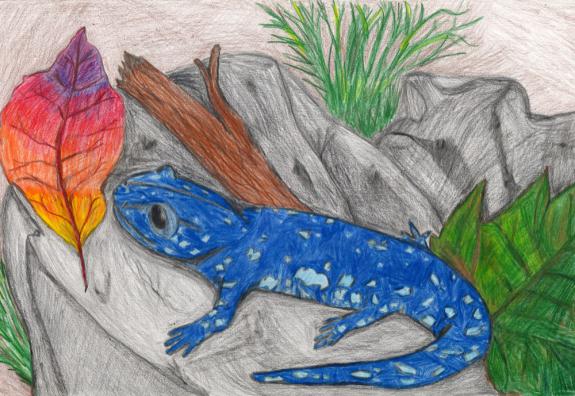Victoria Gonzalez, Clifton Public School # 2
Passaic County
 Blue-spotted salamander. Passaic County. Victoria Gonzalez
Blue-spotted salamander. Passaic County. Victoria GonzalezI am a blue-spotted salamander from the family of mole salamanders. We are called mole salamanders because we spend most of our lives in burrows underground or under rotting logs. We are dark blue with light blue spots and specks on our sides. Blue-spotted salamanders are usually 3 ½ to 5 ½ inches long and have stocky bodies with strong limbs. Our heads are large with eyes that stick out. We like to eat worms, snails, slugs, insects, centipedes, spiders, and other invertebrates. We help humans by eating lots of mosquitoes each year which prevents mosquito overpopulation. We seem quite harmless, but we do have a way to protect ourselves. We have glands on our tails that release a poison when predators try to eat us.
During spring time, we use vernal or spring-time pools for breeding. After the rains get rid of the snow in early March, our nighttime migration to these pools begin. Our instincts lead us back to the area where we were born. Courtship, mating, and laying eggs take place underwater in vernal pools. We sometimes lay small strings of 2 to 10 eggs along sticks or twigs in the temporary ponds. After 3 to 4 weeks, the larvae hatch. They feed on aquatic invertebrates until they start changing 8 to 12 weeks later.
We are endangered because of the destruction of forests and loss of wetlands. We depend on vernal pools to survive. Expanding roads make it difficult for us to reach our vernal pools. We are very sensitive to the quality of water and insecticides and pollution contaminate our water. It is extremely important for our habitats to be protected and stay protected. If our vernal pools are not available and clean we can't breed and we will die out. In Massachusetts there are laws that protect these wetlands. The laws make sure that our vernal pools can't be tampered or changed at all. If these areas are recognized and certified as a protected wildlife habitat, we have a good chance to survive. You can help by going to web sites like www.conservewildlifenj.org and get information on what to do to help us.
Written by: Victoria Gonzalez
Clifton Public School 2, Clifton
Teacher: Ms. Miller




